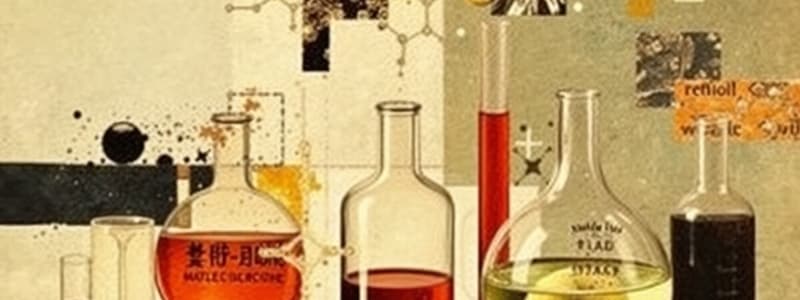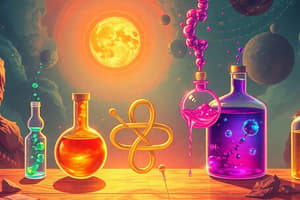Podcast
Questions and Answers
Using the ideal gas law, what is the pressure (in atmospheres) exerted by 3 moles of a gas at a temperature of 22.4 L and 273.15 K?
Using the ideal gas law, what is the pressure (in atmospheres) exerted by 3 moles of a gas at a temperature of 22.4 L and 273.15 K?
- 1.0 atm
- 9.0 atm
- 6.0 atm
- 3.0 atm (correct)
Which of the following statements correctly describes the relationship between variables in Charles's Law?
Which of the following statements correctly describes the relationship between variables in Charles's Law?
- Pressure and temperature are directly proportional at constant volume and number of moles.
- Volume and temperature are inversely proportional at constant pressure and number of moles.
- Volume and temperature are directly proportional at constant pressure and number of moles. (correct)
- Pressure and volume are directly proportional at constant temperature and number of moles.
A gas in a sealed container has a pressure of 3.00 atm, a volume of 10.0 L, and a temperature of 300.0 K. If the volume is increased to 15.0 L and the temperature is lowered to 200.0 K, what is the new pressure?
A gas in a sealed container has a pressure of 3.00 atm, a volume of 10.0 L, and a temperature of 300.0 K. If the volume is increased to 15.0 L and the temperature is lowered to 200.0 K, what is the new pressure?
- 1.33 atm (correct)
- 4.50 atm
- 1.00 atm
- 2.00 atm
What change will increase the root mean square speed of $N_2$ gas?
What change will increase the root mean square speed of $N_2$ gas?
In the van der Waals equation of state for real gases, what does the parameter 'b' account for?
In the van der Waals equation of state for real gases, what does the parameter 'b' account for?
A compound is composed of 92.2% carbon and 7.8% hydrogen by mass. What is the empirical formula of this compound?
A compound is composed of 92.2% carbon and 7.8% hydrogen by mass. What is the empirical formula of this compound?
A compound containing carbon and hydrogen has an empirical formula of CH3 and a molecular mass of approximately 30.08 g/mol. What is its molecular formula?
A compound containing carbon and hydrogen has an empirical formula of CH3 and a molecular mass of approximately 30.08 g/mol. What is its molecular formula?
Given the unbalanced reaction: C2H2(g) + O2(g) → CO(g) + H2O(g), what is the coefficient in front of O2(g) when the equation is balanced?
Given the unbalanced reaction: C2H2(g) + O2(g) → CO(g) + H2O(g), what is the coefficient in front of O2(g) when the equation is balanced?
Consider the reaction: Ag+(aq) + NaCl(aq) → AgCl(s) + Na+(aq). Which ion is the spectator ion?
Consider the reaction: Ag+(aq) + NaCl(aq) → AgCl(s) + Na+(aq). Which ion is the spectator ion?
What is the oxidation state of nitrogen in NaNO3?
What is the oxidation state of nitrogen in NaNO3?
In the unbalanced combustion reaction: C2H2(g) + O2(g) → CO(g) + H2O(g), which reactant acts as the reducing agent?
In the unbalanced combustion reaction: C2H2(g) + O2(g) → CO(g) + H2O(g), which reactant acts as the reducing agent?
Given the reaction: 2 H2(g) + O2(g) → 2 H2O(g), if 8.08 g of H2(g) reacts with excess O2(g) to produce 54.06 g of H2O(g), what is the percent yield of the reaction?
Given the reaction: 2 H2(g) + O2(g) → 2 H2O(g), if 8.08 g of H2(g) reacts with excess O2(g) to produce 54.06 g of H2O(g), what is the percent yield of the reaction?
Consider the reaction: 2 C2H2(g) + 5 O2(g) → 4 CO2(g) + 2 H2O(g). If 13.02 g of C2H2(g) is combusted in excess oxygen, what mass of CO2(g) will be produced?
Consider the reaction: 2 C2H2(g) + 5 O2(g) → 4 CO2(g) + 2 H2O(g). If 13.02 g of C2H2(g) is combusted in excess oxygen, what mass of CO2(g) will be produced?
Flashcards
Avogadro's Law
Avogadro's Law
Relates moles and volume of a gas at constant temperature and pressure.
Boyle's Law
Boyle's Law
Relates pressure and volume of a gas at constant temperature.
Charles's Law
Charles's Law
Relates volume and temperature of a gas at constant pressure.
Moles and volume relationship
Moles and volume relationship
Signup and view all the flashcards
Pressure and temperature relationship
Pressure and temperature relationship
Signup and view all the flashcards
Empirical Formula
Empirical Formula
Signup and view all the flashcards
Molecular Formula
Molecular Formula
Signup and view all the flashcards
Molarity (M)
Molarity (M)
Signup and view all the flashcards
Dilution
Dilution
Signup and view all the flashcards
Mass Percent
Mass Percent
Signup and view all the flashcards
Spectator Ion
Spectator Ion
Signup and view all the flashcards
Oxidation State
Oxidation State
Signup and view all the flashcards
Reducing Agent
Reducing Agent
Signup and view all the flashcards
Study Notes
- A compound is 92.2% Carbon and 7.8% Hydrogen by mass.
- The empirical formula for the compound is C2H2.
- A compound containing carbon and hydrogen with an empirical formula of CH3 has a molecular mass of about 30.08 g/mole.
- C2H6 is the molecular formula.
- Molarity of H2O in 1.00 L of pure water, assuming a density of 1.00 g/mL, needs to be calculated.
- 50.0 mL of a 10.0 M HNO3(aq) solution is diluted to a final volume to obtain a 2.0 M HNO3(aq) solution, this requires calculation.
- A 2.500 M solution of propylene glycol (MM=76.09 g/mol) in water has a density of 1.030 g/mL.
- The mass percent of propylene glycol in water needs to be calculated.
Balancing the reactions
- The coefficient in front of O2(g) after balancing the reaction C2H2(g) + O2(g) -> CO(g) + H2O(g) should be provided.
- The spectator ion in the reaction Ag+(aq) + NaCl(aq) -> AgCl(s) + Na+(aq) can be either: Ag+(aq), NaCl(aq), AgCl(s), Na+(aq), or Cl-(aq).
- The oxidation state of nitrogen in NaNO3 must be determined.
- In the unbalanced combustion reaction C2H2(g) + O2(g) -> CO(g) + H2O(g), the reducing agent is one of the following: carbon, hydrogen, or oxygen.
- Alternatively, there might be no reducing agent in this unbalanced combustion reaction.
- 8.08 g of H2(g) reacts with an excess of O2(g) to form 54.06 g of H2O(g) in the reaction 2 H2(g) + O2(g) -> 2 H2O(g).
- The percent yield for this reaction needs to be determined.
- A 20.00 mL sample of aqueous HCl is titrated with 15.00 mL of 0.100 M NaOH(aq).
- The molarity of the HCl solution in mM must be calculated.
- Given the balanced reaction 2 C2H2(g) + 5 O2(g) -> 4 CO2(g) + 2 H2O(g), 13.02 g of C2H2(g) is combusted in the presence of excess oxygen.
- The mass of CO2(g) produced needs to be determined.
- The pressure in atmospheres needs to be calculated for two moles of gas at 273.15 K in a container with a volume of 11.2 liters.
Matching Gas Laws
- Avogadro's Law describes the relationship between moles and volume.
- Boyle's Law describes the relationship between pressure and volume.
- Charles's Law describes the relationship between volume and temperature.
Proportionality matching
- Moles and volume are directly proportional.
- Pressure and temperature are directly proportional.
- Volume and temperature are directly proportional.
- Moles and pressure are inversely proportional.
- A gas sample has a volume of 20.5 L at 300.0 K and 2.00 atm.
- The volume of the gas at 1.00 atm and 150.0 K must be determined.
- The root mean squared speed of He(g) in the room, if the temperature of the room is 30.0 °C must be determined.
- For a 2.00 mol sample of Cl2(g) at 300.0 K and a pressure of 2.00 atm, the van der Waals' volume (in liters) must be calculated.
- For Cl2(g), a = 6.49 L² atm/mol² and b = 0.0652 L/mol
- The van der Waals equation is given by [P + a(n/V)^2](V-nb) = nRT
- The value of the $b$ parameter increases, the van der Waals' volume becomes less than the ideal volume under conditions of constant temperature and constant moles in the van der Waals equation..
Studying That Suits You
Use AI to generate personalized quizzes and flashcards to suit your learning preferences.
Related Documents
Description
Calculations based on balancing equations. Includes empirical and molecular formulas. Also covers molarity, dilutions, and mass percent calculations in solutions.




